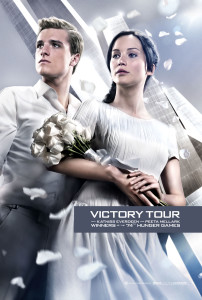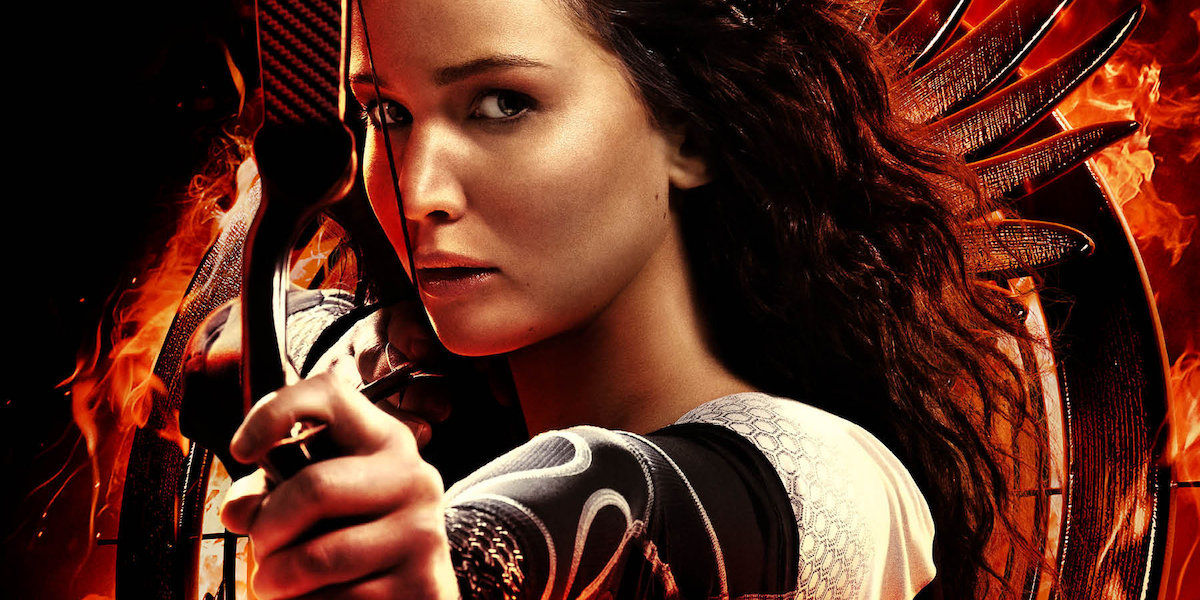Katniss is back, and there’s gonna be trouble.
The follow-up to The Hunger Games, Catching Fire is a film whose specifics seem to be poles apart. It is the rousing, character driven continuation of a near-future saga that somehow combines widescreen metaphors, close-quarter soap opera and spectacle not only for the sake of boffo IMAX spectacle but also as critique of spectacle. But Catching Fire is also, and this is said without any shame or stigma attached along, the middle bit.
That middle bit status doesn’t mean anything too horrible — The Empire Strikes Back was a middle bit, for one example — but it is, as a statement of fact, a good indicator of much of what happens in Catching Fire as Jennifer Lawrence’s Katniss Everdeen is plunged back into the thick of various arenas, both literal and metaphorical. Director Francis Lawrence takes over from Gary Ross — Lawrence is also signed for the two-film enterprise that will adapt the final book in the series — and brings a glossy, fleet sensibility to this film while staying within all of the world-building Ross and his crew did.
What makes The Hunger Games film series stand out isn’t just the grim, too-close-for-comfort future it depicts or the ridiculously talented and broad cast. In the books and in the films, the whole proceedings aren’t driven by some chosen-one prophecy or accident of birth, but rather cruel fate and a series of moral choices presented to Katniss where the options are: bad or worse. In the books, Katniss and her world are brought to life by her constant first-person narration; what’s interesting is that with Jennifer Lawrence as Katniss in the films, there’s no voice-over whatsoever, just Lawrence and her reactions. And those both tell us exactly what we need to know. (Kristen Stewarts’ emotional investment made the tedious soap-operatic story of the Twilight films even vaguely close to tolerable; working with actual material, Lawrence makes the very good Hunger Games series excellent.)
The other interesting thing about Catching Fire is how, like the first film, it’s a spectacle about the dangers of spectacle — the Games themselves are just very complicated circuses to help people keep their mind off how there isn’t any bread — and that this may be the first YA series that’s not just about the making of a hero but also about the selling of one; both sides, oppressor and rebel, are very concerned with their optics, and Katniss figures very heavily in both their plans.

The supporting cast is broad and superb, but standouts include Sam Claflin and Jena Malone, both full of menace and charisma as fellow competitors in the games, as well as returning master of ceremonies Stanley Tucci, with exquisite hair, childlike enthusiasm and a carnivore’s blinding smile. The effects are solid, helping create the future world of the series, but for all of this world’s hovercraft and genetically engineered animals, it’s still a place where the familiar, dead buzz of the fluorescent lights still sounds like apprehension and bad news.
Catching Fire is smart, subversive and constructed to be as unquestionably engaging even as it engages you with its questions; as much as I like the Fast and Furious films, no one’s inspired to think about the power of the state, the complicity of the crowd and the need for dissent after one of them. The final scene will put anxious fans in a state of what can best be called Katniss interruptus, until the first installment of the series two-part closer Mockingjay is released — and that’s exactly as it should be. The first rule of show business — whether in the theater, or in this case, on the screen — is to always leave them wanting more. We’ve been promised an inferno, but Catching Fire smolders for so long that when it finally does burst into burning, right before the final shot, the blaze matters. The Hunger Games was the most interesting, best-made, ambitious and purely enjoyable American science fiction film since The Matrix; Catching Fire not only maintains that level of quality but builds on it. This is the middle bit, yes, but it also points out just how big — and how bold — the plan for this series is, and Catching Fire gives fans more than enough to travel hopefully, even as they wait expectantly to finish the journey.
More Catching Fire on Cinephiled:
Killer Tributes: Who’s Who In ‘Catching Fire’
Know Your Peeta From Your Gale: Who’s Who In ‘Catching Fire’
The Final ‘Catching Fire’ Trailer
8 ‘Catching Fire’ Movie Reviews You’ll Want to Read

